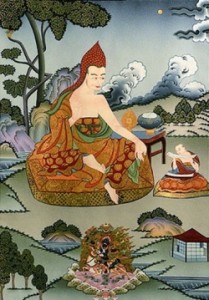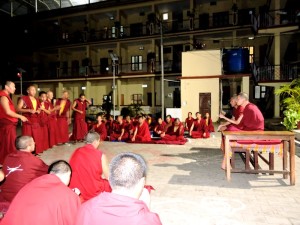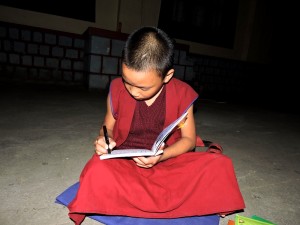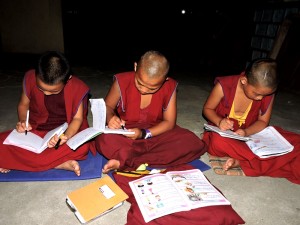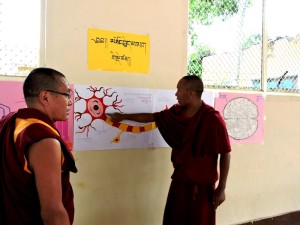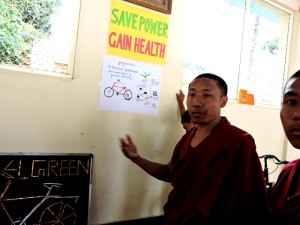Academic Programme
As it is said by the great master Vasubandhu:
“The teaching of the Buddha is of two folds,
Learning and accomplishment,
Cherishing, teaching and practicing is the main purpose of the Buddha teaching.
Great Master Tsongkhapa also said,
From the great learned masters,
Who are unparalleled in analyzing the meaning of the teaching,
With their stainless power of reasons,
May I receive the teaching till the satisfaction of my thirst.”
Tsangpa Khangtsen’s academic programme is for the mental development based on the teachings of the Buddha. It carries on the legacy of the Great Master rJe Tsongkhapa and his disciples which comes from the great masters of Nalanda University. The Nalanda Tradition is deeply rooted in reason and on the facts which are the result of the profound analysis and investigations for centuries by the great masters.
Currently, the concepts explained by the masters of this great tradition are discussed internationally by the well known scientists and scholars of different religious tradition. This tradition analyses the nature of phenomena and advocates the relationship of suffering and happiness of human beings.
This tradition focuses on promoting happiness and peace among individuals and societies through the cultivation of the universal values of love and compassion.
In this way, Tsangpa Khangtsen is making an effort to educate our young monks for the preservation and dissemination of the Naland Tradition of Buddhism.
The monks study for about 20 years on the five major subjects of the Buddhist philosophy which are:
-
Logic (Buddhist epistemology)
-
Prajnanaparmita (mainly five treatises of the Maitreya)
(a) Clear explanation on Abhisamayalamkara by Haribhadra
(b) Golden Garland of Elegant Sayings by Tsongkhapa
(c) The Commentary called Ornament of Heart by Gyaltsab je
(d) Twenty Sangha by Tsongkhapa
(e) The Root and Commentary on Alayvijnana by Tsongkhapa
(f) The treatises on Abhisamayalamkara by Khedup Tendar wa
3. Madhyamaka (Middle way)
(a) Six Great Treatises by Acharya Nagarjuna on Middle Way
(b) Root and Commentary on Madhyamakavatara by Acharya Chandrakirti
(c) Four Hundred Stanzas by Acharya Aryadeva
(d) Clear Meaning of the words, a commentary on Mulamadhyamakakarika by Acharya Chandrakirti.
(e) Illuminating the Thought by Tsongkhapa
(f) Ocean of Reasoning: Commentary on Mulamadhyamakakarika by Tsongkhapa
(g) Opening the eye of thousand sessions
(h) Commentary on Bodhisattava’s Way of Life by Gyaltsab Je
(i) The Treatises on Middle Way by Khedup Tendar Wa.
-
Vinaya (Monk discipline)
-
Abhidharma treatises (Buddhist Metaphysic)
In addition to these subjects the monks also engage in the study of the ritual prayers of both the main monastic college in general and of the house in particular. They study Tibetan grammar, calligraphy, literature, religious history, and Buddhist history. They also engage in the study of general sciences as envisioned by the His Holiness the Dalai Lama for all the monks of the monastic universities in an effort to integrate modern scientific knowledge with Buddhist philosophy.
Academic Structure
There are fourteen classes in this college. While some classes last for a period of two years, most of them last for one year. The arrangement of the classes are made as below:
- Dusda class (Basic Buddhist Logic)
- Tagrig class (Basic Buddhist Logic)
- Shungsar (Prajnanaparmita)
- Shung-nying (Prajnanaparmita)
- Upper Shung-nying (Prajnanaparmita)
- Kab-nyispa (Prajnanaparmita)
- Kab-shipa (Prajnanaparmita)
- Zurkol (Prajnanaparmita)
- Usar (Madhyamaka)
- U-nying (Madhyamaka)
- Zan-kyang (Vinaya & Abhidharma) From this class a student has to face the examination of Gelugpa University for six years and give the debate examination in front of monks of Three great Monastic Universities. After passing the examination, one receives the degree of Geshe Lharampa the highest degree of the Gelugpa Monastic University. During these classes, one studies Pramana the Buddhist epistemology two months each in every winter. ).
- Third Class (Vinaya & Abhidharma)
- Second Class (Vinaya & Abhidharma)
- First Class (Vinaya & Abhidharma)
In contrast to these, a monk student who does not take the Gelugpa University examination faces an internal examination for a Geshe Degree called Geshe Tshokrampa.
Daily Routine
The daily routine of a monk student is divided into four phases.
-
Gathering for congregation in the morning to say prayers from 5.30 am to 6:30 am.
- Memorization of scriptures: up to 9:00 am
- Morning debate session: 9:00 to 11:00 am
- Lunch: 11:00 am to 1:00 pm
- Class for tutor sessions: 1:00 to 5:00 pm
- Dinner: 5:00 pm to 6:00 pm
- Evening Debate Session: 6:00 pm to 9:00 pm
- Recitation Session: 9:30 pm to 11:00 pm (Reciting the texts that a student has memorized)
There is one day off in a week. However, after the completion of summer retreat, there are seven days off. The New Year break is from the 25th day of the 12th month of Tibetan calendar to the 7th day of the first month. Apart from one day celebration of His Holiness’s birthday, there are no breaks throughout the year.
Daily Routine of a young monk going to school
Apart from monk students learning Buddhist Philosophy, the younger monk students attend school to study in a modern setup. The school provides education up to 8th grade. They study Tibetan language and literature, English language, Social Science, Mathematics and General Science. Their routine schedule is as follows:
5:30 am to 8:00 am: Breakfast, Morning Prayer, Memorization of scriptures.
9:00 am – 11:30 am: Classes
11:30 – 11:45: am Lunch
11:45 am – 1:00 pm: Learning Calligraphy (Tibetan)
1:30 pm – 4:00 pm: Classes
4:00 pm – 5:00 pm: Logic Class to the student from 4th to 8th grade
5:00 pm: Dinner
6:00- 8:00 pm: Recitation of the texts learned by-heart.
Students below the third grade do not have philosophy class. They memorize texts and do the recitation practice as scheduled above. A student after finishing 8th grade enters the philosophy class and studies to receive the degree of Geshe Lharampa.

